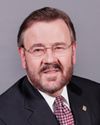Thank you, Madam Chair.
Thank you very much for giving me this opportunity to speak to the members of your committee.
You invited me, along with my colleagues, to speak to you today about the demographic challenges facing Canada's public service.
My presentation—and I promise not to speak for the full 10 minutes—will deal with these challenges, and also with other factors that are radically changing the environment of the public service at this time.
First, with your permission, I would like to explain briefly our responsibilities as an agency, because it has a relatively new role with regard to human resources in the public service.
The agency was created in 2003, when the legislative reforms to the management of human resources in the public service were introduced. Our fundamental raison-d'être is to modernize and foster excellence in people management within the public service.
I arrived as head of the agency last September, which means that I am still relatively new to the wonderful world of human resources. As president of the agency, I am the government's chief human resources officer. Now, government being government, it's never quite as simple as that, and I have to admit we all find that the HR machinery in the government is a bit complex. So while the agency assumes overall leadership on human resource matters in the public service, there are a number of other players with HR responsibilities out there.
First, there's the Treasury Board Secretariat, which has the authority for labour relations and compensation at all levels except the executive, which is a responsibility of the agency. The Public Service Commission has the authority, as you know, for staffing policy and audit, as well as external recruitment. The Canada School of Public Service delivers all the training according to policy that is set by the Treasury Board on advice from this agency. As a consequence, we at the agency have to play a leadership role to bring coherence and direction to all HR matters in the public service, regardless of whether or not the agency itself holds all the actual levers to make things happen in the system.
Given these responsibilities, I was therefore delighted to respond to your invitation to discuss some of the issues we're facing right now, and more importantly, what we're doing about them.
The federal public service, like all other private and public institutions, is facing demographic challenges as the makeup and diversity of the Canadian workforce changes. We need to attract, recruit, develop, and retain our fair share of talent in the face of increasing domestic and global competition for this vital resource. Fortunately, we have a strong base to build upon. The Public Service of Canada is a valued national institution, and interest in working for the public service is very high. The vast majority of our employees are highly dedicated, skilled, and committed to their work. In fact, our most recent survey shows that 96% of employees were strongly committed to making their organization successful. A lot of people in the private sector would be extremely happy with these numbers But the public service is in a state of change. We're facing internal and external challenges that we cannot ignore. I would like to touch on three in particular. They are the changing nature of our work and the labour market, a changing and more diverse population mix, and an aging population.
Starting with the first one, the changing nature of our work and the labour market, we know that the Canadian economy is facing important challenges. Innovation, productivity, and growing competitive pressures are changing the Canadian workforce and the public service. Demand for highly qualified and highly educated workers is growing. Educational levels are rising. The online workplace is a reality for many Canadians.
This evolution has shifted the level and types of skills required in the public service. Based on the definition we use, roughly 58% of our employees are now knowledge workers, whereas ten years ago this number was about 40%. Globalization has in many ways changed the way we do business, and the business we do, and technological advancements have transformed how we provide services to Canadians. ln addition, the talent pool from which we are drawing is becoming more scarce with such a competitive labour market.
Canada's labour force has changed just as the very nature of its work has changed. Recent trends in immigration, the greater participation of women in the labour market, a growing aboriginal population and new language profiles have brought greater diversity to the labour force. According to forecasts from Statistics Canada, visible minorities could make up 21% of the Canadian population within 10 years. Obviously, the labour market will become even more diversified.
Currently, the public service is doing well in dealing with the representation of women, aboriginal people and handicapped persons. We hire members from all of these designated groups beyond their availability on the Canadian job market.
However, we must do much better with regard to visible minorities. This is a designated group that needs more sustained efforts on our part.
Clearly, we have made some progress. The representation of visible minorities went up from 5.5% in 2000 to 8.1% in 2005 and 8.6% in 2006. However, this is obviously not enough.
Of course, we must continue ensuring the geographic representation of all of Canada's regions within the public service.
The last trend I'd like to address is our aging public service. It's true that Canada's public service is aging. The demographics of the country as a whole show a similar trend.
The current average age of a public servant is 45. This is five years older than in 1990, when the average age was 40. The current average age of a public service executive is 50. The age of a brand-new executive is 46. More than half of all public servants are now over 45.
Departure rates for the public service are traditionally low as compared with the private sector. In the private sector they're at about 8%, and we're at just a little over half that. We expect retirements to peak at around 2013 and then slowly come back down.
The ranks of our youngest employees are strong. Generations X and Y account for 31% of the public service. So we do have a solid foundation to build upon.
We also know that interest in public service jobs is still very high, as Madame Barrados highlighted in her presentation to this committee last month.
If you ask me, therefore, “Is there a crisis looming?”, I will answer, well, maybe, if we were complacent--but we're not. Are we taking these pressures seriously? Absolutely.
One of the first things the Clerk of the Privy Council put on his agenda as head of the public service, when he assumed the responsibility a year ago, was the need to renew the public service. The moment he arrived, Kevin Lynch turned his attention to these challenges and the need for renewal. He launched a process of renewal of the public service based on a practical, results-oriented management approach to achieving and sustaining excellence in the public service. He is doing this with the full support of the Prime Minister and Minister Toews, President of the Treasury Board.
Kevin Lynch created a senior forum of deputy ministers to drive this process of renewal. This deputy minister committee, which is supported by my agency, has been working hard, and has brought forward, after careful analysis of the issues, some specific priorities for action.
We have defined four priority sectors that require our attention.
First, there is integrated planning. We need to understand clearly our current and future activities in the departments and make sure that we have the people and the resources that we need to carry them out. Essentially, we must plan for our needs in personnel at the same time as we make our business plans, so that we can balance our resources.
Secondly, we must deal with recruiting. We must renew and maintain our capacity at all levels. Currently, 86% of our hiring meets our short-term needs, and this is why we need integrated strategic planning. We must also give the public service a better profile as a dynamic and stimulating career choice.
Third, there is training. We must invest in people at all levels, not only to improve their skills, but also to encourage the leadership that we need in the long term.
Fourth, we need a basic infrastructure with systems, procedures and tools that can support planning, recruiting and training. When Parliament adopted the Public Service Modernization Act, it provided us with means for improving our human resource management.
However, we still need to modernize the entire administrative structure that the new legislation involves. This obligation has a great deal of impact, not only on the efficiency and the cost of human resource services, but also on the perception that the younger generation has of the public service, because we want to keep the new recruits with us.
This concrete and practical action plan, based on these priorities, is fully described in the clerk's most recent annual report, which actually was tabled yesterday in Parliament, and I believe that every member of Parliament has received a copy already. Thank you, Chair.
The report is our road map for public service renewal, and it's our response to the challenges we face as an institution. We will certainly be glad to provide this committee with updates as our work progresses.
In closing, Madame Chair, I hope you will agree with me that yes, there are real challenges before us, but the public service is well positioned to effectively manage future pressures. And while we recognize that there is still a lot of work to do, we are confident in our approach. I would certainly welcome your questions and your comments.
Merci beaucoup.






